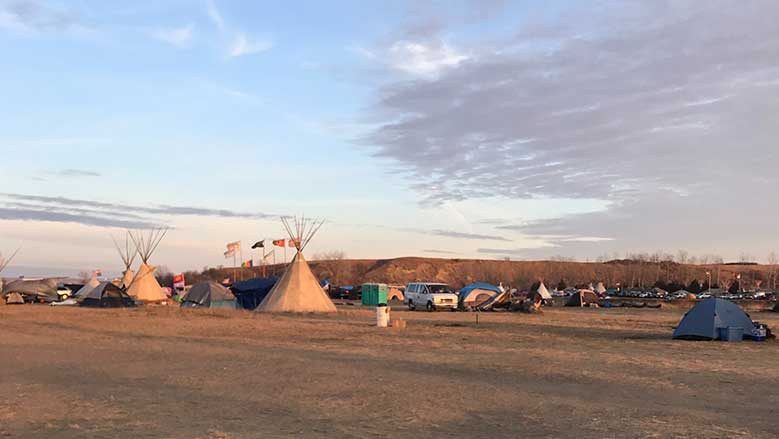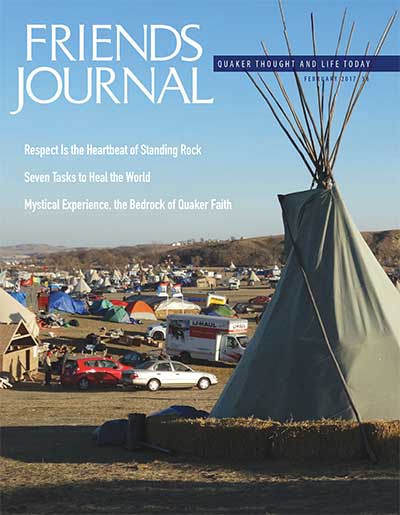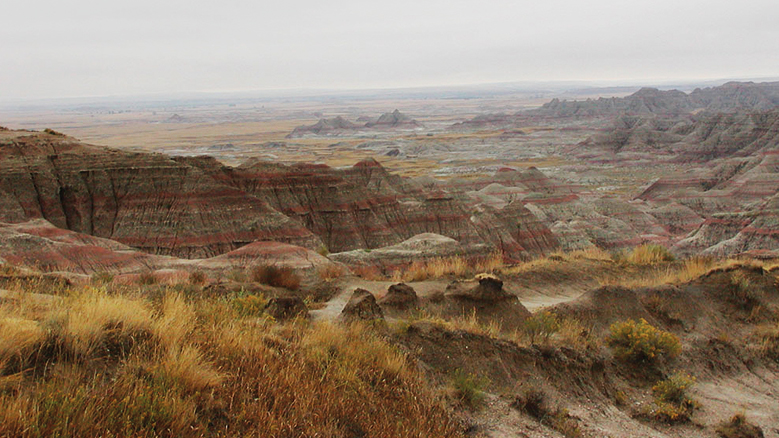
Strange combinations of beauty and blight were everywhere when I set out for Standing Rock, North Dakota, home of the Lakota Sioux. I chose to travel by train in order to have the blessed time to prepare mentally and emotionally to be present at Standing Rock and to limit my carbon footprint. Within 15 minutes from departure time, I was rolling around the beautiful northern shore of San Francisco Bay right through the Richmond oil refineries. A few hours later in the Sierra foothills, tall evergreens were equally interspersed with rust-brown dead and dying trees, due to a beetle infestation caused by the drought. This contrast of the land’s grand beauty with blight followed me all the way to the incredible North Dakota big sky, which was juxtaposed with oil pumps, pipelines, and police brutality.
After spending a few days at Standing Rock, I was struck by the similarities to Gandhian nonviolence. As explained by Chris Moore-Backman in his book The Gandhian Iceberg, Gandhian practice has three important components: grounding in Spirit, a beloved community, and direct action. Practitioners first ground their behavior and their actions in prayer and guidance from Spirit. They surround themselves in a community of like-minded people, all supporting each other materially and emotionally. When they are called to action, the call comes from a deep place of prayer and Spirit, and is supported by the entire community.
The Standing Rock community is welcoming, mutually supportive, nurturing, and prayer-based. There is one main camp of water protectors, Oceti Sakowin, and a separate nearby camp, Sacred Stone (the original core camp). Within Oceti Sakowin, different tribes and themes have camping clusters, including Two-spirit camp for LGBTQ folks; Red Warrior camp (for those most focused on direct action, off-limits to visitors); the media and legal teams; and medical support. Oceti Sakowin is on contested treaty land, now controlled by the Army Corps of Engineers, and, as of this writing, residents have been threatened with eviction. Just across the Cannonball River, there is a much smaller camp on the Standing Rock Reservation for families and women.
Three of us from Quaker Earthcare Witness (QEW) felt called to visit Oceti Sakowin in mid-November. We felt moved to participate with this historic gathering of now over 400 indigenous communities and anywhere from 3,000 to 10,000 people gathered to protect the Missouri River watershed from a proposed oil pipeline. The Lakota are holding the government accountable to the 1851 Fort Laramie Treaty that ceded land to them, even though in practice, that land has not been theirs to use. Thirty-eight miles of the pipeline will travel over this contested land. I brought a statement of support from QEW, as approved in September. Carol Barta brought a statement of support and winter supplies donated by Quakers and Mennonites from her Manhattan, Kansas, community. Judy Lumb, who resides in Belize, brought a statement of solidarity and a flag from the Garifuna, one of the indigenous groups of Belize. We understood that we were visitors and observers, and we minimized our use of resources at the camp by staying overnight off-site. We are inspired by the Lakota who say, “Mni Wiconi” (Water is Life). They know that living well can only come from a harmonious relationship with the natural world.
Standing Rock has served as an inspiration to both indigenous and non-indigenous people. I encourage you to go directly to indigenous organizations and leaders to hear what this is all about. Some places to start are sacredstonecamp.org, ocetisakowincamp.org, and the Indigenous Environmental Network on Facebook for day-to-day updates.
In our local communities, inspiration to support the water protectors at Standing Rock was palpable. Supplies flowed in as soon as Carol let her community know that she was traveling to Standing Rock. When a farmer died ten years ago, his wife could not let go of his large supply of Carhartts, extremely warm overalls that are used throughout the prairie by people who have to work outdoors in the winter. This was the time for her to let go, with much joy that her husband’s supplies would be well used. The day after we dropped off our supplies, we saw someone walking around in one of those Carhartts. Not only did Carol’s community quickly rise to the challenge of donating supplies, but two Friends took one look at Carol’s tiny car and immediately handed her the keys to their van for our transportation.
In all of the stories told about brutal treatment of the water protectors, it is rare to hear about the peaceful and Spirit-led day-to-day flow of the main camp, Oceti Sakowin. We were never made to feel out of place, even though we were newcomers, didn’t know all the routines, and were non-indigenous. Our gifts of winter clothes and warm sleeping bags and blankets were greatly appreciated; our presence, even more.
The first glimmer that you are entering a different kind of community comes when you drive past some of the more than 400 flags that indigenous groups have sent to Oceti Sakowin. At first, the camp seems a hodge-podge of structures: teepees and tarpees mixed up with army-like mess tents, standard nylon tents, tiny houses, yurts, and a large dome. Twice a day prayer circles happen in a central plaza, followed by announcements. Nearly every day, there is a nonviolence action training and a newcomers’ orientation. The first place we stopped was the free store.
Due to blowing snow and ice, Carol and I didn’t arrive at camp until midday on November 19. As soon as we started unloading supplies, a camper approached us to ask if we had any warm boots. Carol asked what size. The camper desperately needed women’s size 7.5 to replace the rubber rain boots she was wearing (fine for Portland, Oregon, but not for winter in North Dakota). The only boots we had with us were women’s size 7.5. Yes! Soon after, we were approached by a woman looking for blankets and sleeping bags for the women’s tent. This is a tent set up in the family camp across the river for women to gather daily and to provide a relaxing space during menstruation. It felt like the perfect home for our supply of five extra-warm sleeping bags and several blankets.
On the fateful day of Sunday, November 20, Lakota elders spent all day in prayer and discussion. That evening water protectors on the frontline tried to clear Highway 1806 to the north for traffic, the road having been blocked by authorities in late October. (The day before we had observed how an ambulance took an extra 30 minutes to arrive at camp due to the road closure.) That evening, water protectors on Highway 1806 were met with tear gas, water hoses dousing them in sub-freezing temperatures, and explosive devices that resulted in the probable loss of one woman’s arm.
Earlier in the day, however, much of camp life went on as usual. Three meals are prepared daily and shared throughout camp. Judy helped with lunch that day, and she ferried water around the camp (see her blog at judylumb.wordpress.com). Camp etiquette includes honoring elders in many ways. One simple way is that when lunch is ready, young people bring plates of food to elders as a show of respect. There we were: three older Quaker women sitting in the sun near the main fire pit. Suddenly two young people brought us plates of food! We were grateful.
When we met someone, there was always time for a talk. That was more important than rushing off to “do something.” This is how relationships are forged. This is how important relationships are in this community.
Not that there wasn’t much going on: lots of winterizing to prepare for the fierce winds and cold common in North Dakota winters. The construction crews were determined and working diligently. We saw an impressive crew putting up a straw bale structure. Another crew was assembling a food storage shed for keeping food from freezing. Teepees and tarpees were everywhere. A local Lakota young man invited us inside his canvas teepee with a small wood stove, which was incredibly warm and cozy on a 25-degree day. Tarpees follow the structure of teepees but use tarp instead of canvas for the walls and include a clever smoke-hole design. Carol is connected with a Seattle group that designed these and donated supplies to set up 80 of them at Standing Rock. We met three Navaho from Arizona who had spent the night in a tarpee. They reported it was spacious but in need of a wood stove for warmth (the stoves are on the way).
A few hours after we left Standing Rock, the people we had casually chatted with were being sprayed with water in sub-freezing temperatures. A week after we left, the sunny, central plaza in Oceti Sakowin was blanketed with snow; the wind was howling; and inhabitants of Oceti Sakowin camp were threatened with eviction. We left the camp filled with love and respect for those on the frontlines, for Lakota elders who inspired and led the effort, and for all of us who, in big and small ways, consider ourselves water protectors. Mni Wiconi.
As of December 4, 2016, the Army Corps of Engineers denied the easement to put the pipeline under the Missouri River and stated that an Environmental Impact Statement (EIS) is required to complete the project. On January 18, two days before President Obama left office, the Corps issued a notice of intent to complete an Environmental Impact Statement on the Dakota Access Pipeline at Standing Rock. Time will tell whether this gathering of spirit becomes yet another instance of invasion and destruction of an indigenous community, or serves as a pivot point for how we all relate to the natural world. What role do Friends have?


















Comments on Friendsjournal.org may be used in the Forum of the print magazine and may be edited for length and clarity.